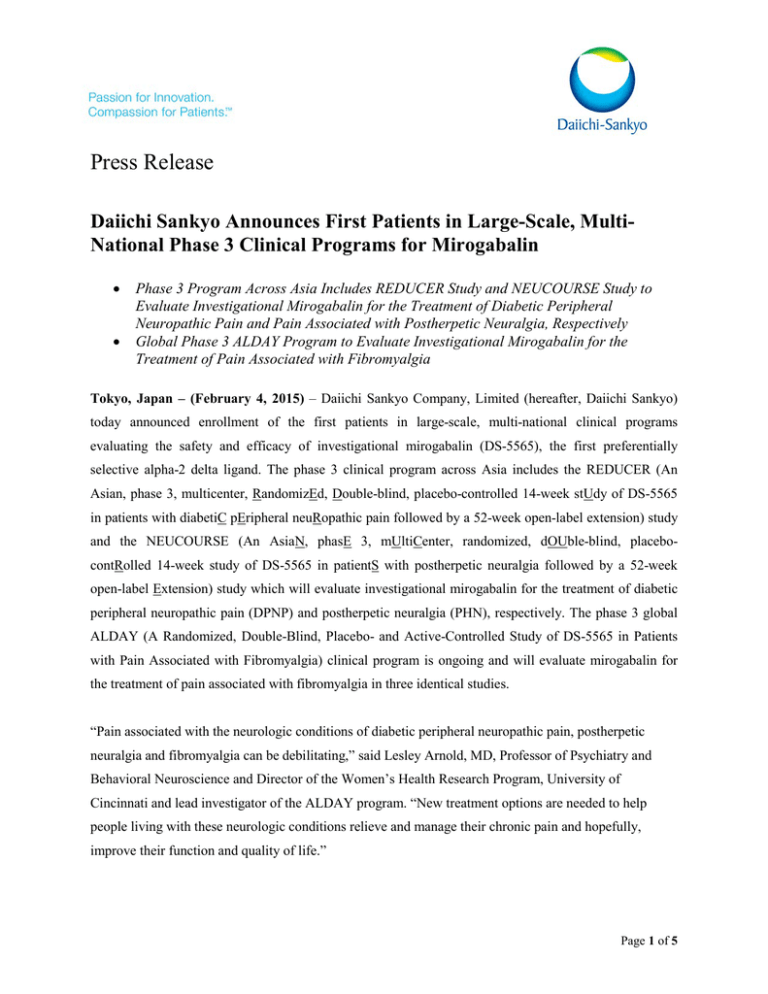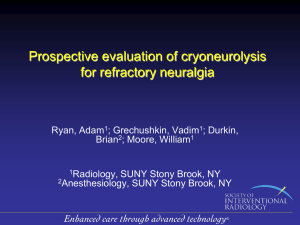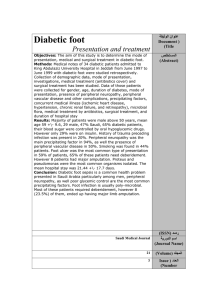Press Release - Daiichi Sankyo
advertisement

Press Release Daiichi Sankyo Announces First Patients in Large-Scale, MultiNational Phase 3 Clinical Programs for Mirogabalin • • Phase 3 Program Across Asia Includes REDUCER Study and NEUCOURSE Study to Evaluate Investigational Mirogabalin for the Treatment of Diabetic Peripheral Neuropathic Pain and Pain Associated with Postherpetic Neuralgia, Respectively Global Phase 3 ALDAY Program to Evaluate Investigational Mirogabalin for the Treatment of Pain Associated with Fibromyalgia Tokyo, Japan – (February 4, 2015) – Daiichi Sankyo Company, Limited (hereafter, Daiichi Sankyo) today announced enrollment of the first patients in large-scale, multi-national clinical programs evaluating the safety and efficacy of investigational mirogabalin (DS-5565), the first preferentially selective alpha-2 delta ligand. The phase 3 clinical program across Asia includes the REDUCER (An Asian, phase 3, multicenter, RandomizEd, Double-blind, placebo-controlled 14-week stUdy of DS-5565 in patients with diabetiC pEripheral neuRopathic pain followed by a 52-week open-label extension) study and the NEUCOURSE (An AsiaN, phasE 3, mUltiCenter, randomized, dOUble-blind, placebocontRolled 14-week study of DS-5565 in patientS with postherpetic neuralgia followed by a 52-week open-label Extension) study which will evaluate investigational mirogabalin for the treatment of diabetic peripheral neuropathic pain (DPNP) and postherpetic neuralgia (PHN), respectively. The phase 3 global ALDAY (A Randomized, Double-Blind, Placebo- and Active-Controlled Study of DS-5565 in Patients with Pain Associated with Fibromyalgia) clinical program is ongoing and will evaluate mirogabalin for the treatment of pain associated with fibromyalgia in three identical studies. “Pain associated with the neurologic conditions of diabetic peripheral neuropathic pain, postherpetic neuralgia and fibromyalgia can be debilitating,” said Lesley Arnold, MD, Professor of Psychiatry and Behavioral Neuroscience and Director of the Women’s Health Research Program, University of Cincinnati and lead investigator of the ALDAY program. “New treatment options are needed to help people living with these neurologic conditions relieve and manage their chronic pain and hopefully, improve their function and quality of life.” Page 1 of 5 “We are pleased that our global clinical development program evaluating the efficacy and safety of mirogabalin continues to move forward and has progressed into phase 3,” said Mahmoud Ghazzi, MD, PhD, Executive Vice President and Global Head of Development for Daiichi Sankyo. “Daiichi Sankyo is committed to identifying and studying new medicines that could help improve the management of chronic pain for people with diabetic peripheral neuropathy, postherpetic neuralgia and pain associated with fibromyalgia.” About the REDUCER and NEUCOURSE Phase 3 Clinical Studies The REDUCER study will last 14 weeks and is being conducted at approximately 200 centers in Japan, Taiwan and Korea. The NEUCOURSE study will also last 14 weeks and is being conducted at approximately 200 centers in Japan, Taiwan, Korea, Singapore, Malaysia and Thailand. The studies will include about 750 patients each with either diabetic peripheral neuropathic pain or postherpetic neuralgia, respectively. The objectives of the double-blind studies are to evaluate safety and efficacy of mirogabalin by comparing change in the average daily pain score (ADPS) from baseline to Week 14 in patients receiving a total daily dose of either 15 mg, 20 mg or 30 mg of mirogabalin versus placebo. Both studies will be followed by one-year open-label extension studies to assess long-term safety and efficacy of mirogabalin. For more information on the REDUCER study in patients with diabetic peripheral neuropathic pain, please visit https://www.clinicaltrials.gov/ct2/show/NCT02318706?term=Mirogabalin&rank=3. For more information on the NEUCOURSE study in patients with postherpetic neuralgia, please visit https://www.clinicaltrials.gov/ct2/show/NCT02318719?term=Mirogabalin&rank=1. About the ALDAY Phase 3 Clinical Program The ALDAY program is a large clinical phase 3 program evaluating mirogabalin for the treatment of pain associated with fibromyalgia, and includes three, randomized, double-blind, placebo- and activecontrolled studies, and an open label safety study that will be carried out over the next three years. Approximately 4,000 patients with pain associated with fibromyalgia will be enrolled at approximately 800 clinical centers at more than 40 countries worldwide. The primary objective of the studies in the ALDAY program is to compare change in weekly ADPS from baseline to Week 13 in patients receiving a total daily dose of either 15 mg or 30 mg of mirogabalin versus placebo. Weekly ADPS is based on daily pain scores reported by the patient that best describes his or her worst pain over the previous 24 hours. The primary objective of the phase 3 open-label extension study is to assess the long-term safety of a total daily dose of mirogabalin 15 mg or mirogabalin 30 mg in patients with pain associated with fibromyalgia. For more information on the studies in the ALDAY program, please visit Page 2 of 5 https://clinicaltrials.gov/ct2/show/NCT02187471?term=DS5565&rank=1 https://clinicaltrials.gov/ct2/show/NCT02187471?term=ds-5565&rank=2 https://clinicaltrials.gov/ct2/show/NCT02146430?term=ds-5565&rank=3 For more information on the open-label extension study, please visit https://clinicaltrials.gov/ct2/show/NCT02234583?term=ds-5565&rank=4 For patient recruitment or additional clinical study information, please visit http://www.aldaystudy.com/. About Diabetic Peripheral Neuropathic Pain Diabetic peripheral neuropathy is a disorder that causes nerve damage to the extremities and is one of the most common long-term complications of diabetes.1 Symptoms include sharp pains or increased sensitivity, numbness, loss of balance and coordination, tingling, burning, or prickling sensations, which typically worsen at night.1 Up to 50 percent of people with diabetes have peripheral neuropathy2 and it is estimated that between 11 and 26 percent of people with diabetes experience diabetic peripheral neuropathic pain (DPNP).3-6 However, DPNP is often undertreated and underreported.2 About Postherpetic Neuralgia Postherpetic neuralgia is pain that occurs after recovering from shingles, an infection that is caused by the herpes zoster (chickenpox) virus. Pain from postherpetic neuralgia can range in severity, and is typically described as burning, sharp, or stabbing.7 Other symptoms include sensitivity to touch, itching, numbness, and in rare cases, muscle weakness or paralysis can occur.7 The risk of developing postherpetic neuralgia increases with age and it mainly affects people older than 60.7 Studies have shown that only half of all patients affected with the condition will be relieved from pain within a year.8 Most people will require more than one treatment to help ease the pain.7 About Fibromyalgia Fibromyalgia is a chronic disorder that causes widespread muscle pain, generalized tender points and fatigue.9 Other common symptoms include sleep disturbances, morning stiffness, memory and thinking problems (sometimes called fibro fog), tingling in the hands and feet and headaches.9 Fibromyalgia is often misdiagnosed and suboptimally treated.10-17 The overall estimated prevalence of fibromyalgia is approximately two to three percent in the general population, with a higher prevalence in women.18-22 Pain that occurs with fibromyalgia has a substantial impact on the patient, and can be associated with societal and economic burdens.23-29 About Mirogabalin Page 3 of 5 Mirogabalin is an investigational drug that is currently being studied for the treatment of DPNP, PHN and pain associated with fibromyalgia. Mirogabalin is preferentially selective in regards to how it binds to α2δ-1 subunit, a protein that may help to regulate how the brain processes pain signals. It has a unique binding profile and long duration of action.30*,31 About Daiichi Sankyo Daiichi Sankyo Group is dedicated to the creation and supply of innovative pharmaceutical products to address the diversified, unmet medical needs of patients in both mature and emerging markets. While maintaining its portfolio of marketed pharmaceuticals for hypertension, dyslipidemia and bacterial infections used by patients around the world, the Group has also launched treatments for thrombotic disorders and is building new product franchises. Furthermore, Daiichi Sankyo research and development is focused on bringing forth novel therapies in oncology and cardiovascular-metabolic diseases, including biologics. The Daiichi Sankyo Group has created a "Hybrid Business Model," to respond to market and customer diversity and optimize growth opportunities across the value chain. For more information, please visit: www.daiichisankyo.com. Global and US Contact Kimberly Wix Daiichi Sankyo, Inc. kwix@dsi.com +1 973 944 2338 (office) +1 908-656-5447 (mobile) EU Contact Dr. Michaela Paudler-Debus Michaela.Paudler-Debus@daiichi-sankyo.eu Daiichi Sankyo Europe +49 89 7808685 (office) Japan Contact Teiichiro Koga koga.teiichiro.zp@daiichisankyo.co.jp Daiichi Sankyo Co., Ltd. +81-3-6225-1126 (office) Forward-looking statements This press release contains forward-looking statements and information about future developments in the sector, and the legal and business conditions of DAIICHI SANKYO Co., Ltd. Such forward-looking Page 4 of 5 statements are uncertain and are subject at all times to the risks of change, particularly to the usual risks faced by a global pharmaceutical company, including the impact of the prices for products and raw materials, medication safety, changes in exchange rates, government regulations, employee relations, taxes, political instability and terrorism as well as the results of independent demands and governmental inquiries that affect the affairs of the company. All forward-looking statements contained in this release hold true as of the date of publication. They do not represent any guarantee of future performance. Actual events and developments could differ materially from the forward-looking statements that are explicitly expressed or implied in these statements. DAIICHI SANKYO Co., Ltd. assume no responsibility for the updating of such forward-looking statements about future developments of the sector, legal and business conditions and the company. References 1. 2. 3. 4. 5. 6. 7. 8. 9. 10. 11. 12. 13. 14. 15. 16. 17. 18. 19. 20. 21. 22. 23. 24. 25. 26. 27. 28. 29. 30. 31. National Diabetes Information Clearinghouse. Diabetic Neuropathies: The Nerve Damage of Diabetes. NIH Publication No. 09-3185. February 2009. Boulton, A. Management of Diabetic Peripheral Neuropathy. Clinical Diabetes. 2005; 25(1): 9-15. Sadosky A et al. A review of the epidemiology of painful diabetic peripheral neuropathy, postherpetic neuralgia, and less commonly studied neuropathic pain conditions. Pain Pract. 2008;8(1):45-56. Van Acker K, et al. Prevalence and impact on quality of life of peripheral neuropathy with or without neuropathic pain in type 1 and type 2 diabetic patients attending hospital outpatients clinics. Diabetes Metab. 2009;35(3):206-213. Abbott CA et al. Prevalence and characteristics of painful diabetic neuropathy in a large community-based diabetic population in the U.K. Diabetes Care. 2011;34(10):2220-2224. Tsuji M et al. Painful diabetic neuropathy in Japanese diabetic patients is common but underrecognized. Pain Res Treat. 2013;2013:318352. Mayo Clinic. Postherpetic neuralgia. Available at: http://www.mayoclinic.org/diseases-conditions/postherpeticneuralgia/basics/definition/con-20023743. Accessed on February 19, 2014. American Academy of Neurology. AAN Guideline Summary for Patients: Treatment of Postherpetic Neuralgia. Available at: http://tools.aan.com/professionals/practice/pdfs/pn_guideline_patients.pdf. Accessed on February 19, 2014. National Institute of Arthritis and Musculoskeletal and Skin Diseases. National Institutes of Health. “What Is Fibromyalgia?” July 2011. Hayes SM et al. Pain Res Manag. 2010;15:385-391. Bennett R. Newly Diagnosed Patients. National Fibromyalgia Association. Available at: http://www.fmaware.org/new-diagnosedpatients.html. Choy E et al. BMC Health Serv Res. 2010;10:102. Robinson RL et al. Pain Med. 2013;14:1400-1415. Lauche R et al. Clin Exp Rheumatol. 2013; [Epub ahead of print]. Häuser W et al. J Pain. 2010;11:505-521. Wolfe F et al. Eur J Pain. 2013;17:581-586. Smith B et al. 2011. Available at: http://www.ncbi.nlm.nih.gov/books/NBK55552/. Queiroz L. Curr Pain Headache Rep. 2013;17:356. Masi AT et al. Semin Arthritis Rheum. 2002;32:71-93. Wolfe F et al. Arthritis Rheum. 1995;38:19-28. Zeng QY et al. Arthritis Res Ther. 2008;10:R17. Lawrence RC et al. Arthritis Rheum 2008;58:26-35. Arnold LM et al. Mayo Clin Proc. 2011;86:457-464. White LA et al. J Occup Environ Med. 2008;50:13-24. Sanchez RJ et al. Curr Med Res Opin. 2011;27:663-671. Perrot S et al. BMC Musculoskelet Disord. 2012;13:22. Schaefer C et al. Health Qual Life Outcomes. 2011;9:71. Theadom A et al. J Psychosom Res. 2007;62:145-151. Staud R. Curr Rheumatol Rep. 2009;11:433-436. Yokoyama T et al. J Neurol Sci. 2013;333:e535. *Demonstrated currently in preclinical animal models only. Vinik AI, Rosenstock J, Sharma U, Feins K, Hsu C, Merante D. Efficacy and Safety of Mirogabalin (DS-5565) for the Treatment of Diabetic Peripheral Neuropathic Pain: A Randomized, Double-Blind, Placebo- and Active Comparator-Controlled, Adaptive Proof-of-Concept Phase 2 Study. Diabetes Care 2014; 37(12):3253-3261. Page 5 of 5




